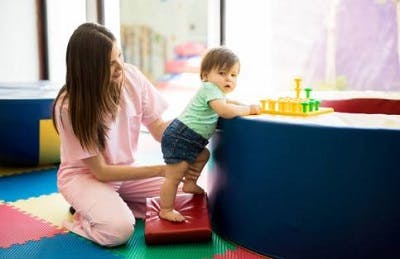Preemies account for anywhere between a third to half of all cerebral palsy diagnoses. Premature infants are born with underdeveloped brains, making them more vulnerable to damage that can cause cerebral palsy.
Thanks to advances in healthcare that allow for early identification and intervention, symptoms and complications of cerebral palsy can be minimized to optimize a child’s quality of life.
This article will go over what to expect if your preemie has cerebral palsy and how to effectively manage it. Use the following link to explore specific sections of this article:
- The link between premature birth and cerebral palsy
- 7 signs of cerebral palsy in preemies
- Management of cerebral palsy in preemies
The Link Between Premature Birth and Cerebral Palsy
For a birth to be considered premature, the baby must be born before 37 weeks. In the US, about 1 in every 10 infants is born prematurely. Preemies are more likely to experience complications the earlier they are born. Preemies with lower birth weights also tend to have a higher risk of complications. Complications with brain development are likely to occur in more than 80% of preemies born before 25 weeks old.
There are many risk factors for premature birth including:
- High blood pressure
- Diabetes
- Genetic influence
- Infections
- Stress
- Carrying multiple babies
- Pre-existing health problems
- Having a previous premature birth or multiple miscarriages
- Problems with the uterus, cervix, or placenta
Mothers of preemies often blame themselves for premature birth but many times, the cause cannot be determined. Even mothers without any risk factors can have premature births. Sometimes, it just happens.
While cerebral palsy can occur in babies born at full term, being born prematurely does increase the risk of having cerebral palsy. Cerebral palsy is caused by damage to the developing brain. Brain damage is more likely to occur in infants born prematurely for several reasons, including:
- Brain bleeds: the earlier a baby is born, the higher the risk of a bleeding in the brain, also known as an intraventricular hemorrhage
- Interrupted brain development: when a baby is born early, the typical patterns of brain development are disrupted, which may cause brain damage
- Oxygen deprivation: as preemies may have underdeveloped lungs, they are more likely to experience low oxygen levels, which can result in damage to brain cells
Just because a preemie has brain damage does not mean that they have cerebral palsy. Cerebral palsy is only caused by brain damage to specific areas of the brain that play a role in movement, including the motor cortex, basal ganglia, cerebellum, and thalamus.
If you’ve recently had a premature baby, focus on staying positive and educate yourself on how to best care for your baby.
7 Signs of Cerebral Palsy in Preemies

About 10% of preemies born before 28 weeks have cerebral palsy.
Therefore, it’s essential to keep an eye out for early signs of cerebral palsy. The sooner you identify complications and seek management for them, the less impact they’ll have on your child’s quality of life.
Here is a list of common signs of cerebral palsy in preemies:
1. Developmental Delays
Typically, developmental delays are the first detectable sign of cerebral palsy in children.
Cerebral palsy can range from mild to severe. Often, mild cases go unnoticed until children start missing developmental milestones. Generally, by 6 months, a baby can roll in both directions and sit without support. Around 12 months old, children can stand, and by 15 months, they can typically walk on their own.
Remember to adjust your preemie’s age! For example, if your baby is 12 months old and was born 8 weeks early, their adjusted age would be 10 months. Not all babies develop at the same pace. Sometimes, infants will be delayed in one area of development, but may be on target or even ahead in other areas.
2. Atypical Walking Patterns
Cerebral palsy can affect various areas of the body. The most common type of cerebral palsy is spastic diplegia, where only the legs have motor impairments. As a result, preemies with spastic diplegia usually have completely typical upper body functions. Motor impairments may only become apparent once the child starts walking.
Walking patterns characteristic of cerebral palsy include:
3. Fatigue
Fatigue is an extremely common outcome of both premature birth and cerebral palsy. Because of their motor impairments, individuals with cerebral palsy have to use more energy to move and tire out much more quickly. As a result, your preemie may require more time to perform everyday activities like feeding and getting dressed.
4. Lack of Interaction with their Surroundings

While it might appear like your child is disinterested in exploring their surroundings, they usually aren’t. Rather, their motor impairments make it difficult for them to move around, which discourages them from interacting with their environment.
5. Favoring One Side of the Body
Spastic hemiplegia is a type of cerebral palsy that only affects one side of the body. While we all have a dominant side, children with spastic hemiplegia may develop a habit of using only one side and avoid engaging the other at all. For example, your child might tend to lean in a certain direction, drag a leg behind when walking or crawling, or clench their affected hand. Management for hemiplegia is essential to develop bilateral coordination.
6. Floppy or Stiff Muscles When Held
Depending on the location of brain damage, preemies may experience extremely high or low muscle tone. When held, children with low muscle tone will feel floppy and might droop their heads. Those with high muscle tone will feel stiff and resist movement, which can make it difficult to place them in a car seat or highchair.
7. Poor Feeding
If cerebral palsy affects the oral motor muscles, children may struggle to chew and swallow their food. As a result, many children with cerebral palsy have feeding difficulties, which puts them at risk for malnutrition and dehydration. Preemies are born smaller than infants born at term. They usually catch up in size around 2-3 years old, but only with proper nutrition.
Management of Cerebral Palsy in Preemies

One of the best practices for managing cerebral palsy in preemies is to get regular well-child checkups to make sure your child is developing at a healthy rate. This can ensure they are getting appropriate nutrition and meeting important developmental milestones.
Physicians often hesitate to diagnose mild cerebral palsy in infanthood because motor impairments identified before the age of 1 often resolve on their own.
However, parents shouldn’t passively wait until symptoms improve or worsen.
Even if your infant doesn’t have cerebral palsy, early intervention for motor problems can significantly improve mobility. If you are uncertain whether your child is demonstrating motor delays, consider using this interactive tool developed by the American Academy of Pediatrics to learn more about what is expected at different ages.
Early intervention for cerebral palsy typically consists of:
- Physical therapy to stretch and strengthen tight muscles, improve range of motion, and promote proper gait patterns
- Occupational therapy to increase participation in play and other daily activities
- Speech therapy address oral motor skills for feeding or communication difficulties
- Proper nutrition to address malnutrition and promote normal growth and musculoskeletal health
- Orthotics to support proper musculoskeletal alignment and gently stretch tight muscles
- Medications to temporarily relieve high muscle tone
Early intervention is proactive and helps address symptoms before they turn into habits or result in further complications. In addition to the above management techniques, general healthy behaviors like eating a nutritious diet and being physically active each day can minimize symptoms and complications of cerebral palsy.
Since play is vital to developing motor skills in infants and children, setting up a play area optimally can also help to manage cerebral palsy symptoms. Try to enrich your child’s environment as much as possible by using brightly colored toys, toys of various textures, or toys that make noises to stimulate the senses (but be careful not to overdo this and cause sensory overload). Bring toys closer to the child to encourage them to use their fine motor skills to explore as much as possible.
Ensure that toys are developmentally appropriate and engaging for your child. Playing outdoors can also encourage more natural environmental interactions and gross motor movements through activities such as digging in a sandbox, swimming, or playing in a pile of leaves.
Early management of cerebral palsy is ideal because children’s brains have more plasticity than adult brains, which makes it easier for them to adapt and replace abnormal movement patterns. The younger the child is, the easier it is for their brains to learn and adapt.
Understanding Cerebral Palsy in Preemies: Key Points
Children born prematurely have an increased risk of cerebral palsy. Therefore, parents need to be aware of what symptoms to look out for and seek management as early as possible.
Hopefully, this article helped you better understand cerebral palsy in preemies and the importance of early management.











